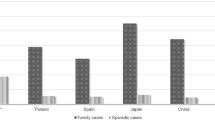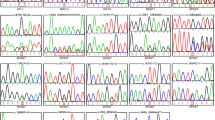Abstract
Molecular characterization is important for an accurate diagnosis in hereditary spastic paraplegia (HSP). Mutations in the gene SPAST (SPG4) are the most common cause of autosomal dominant forms. We performed targeted next generation sequencing (NGS) in a SPAST-negative HSP sample. Forty-four consecutive HSP patients were recruited from an adult neurogenetics clinic in Sydney, Australia. SPAST mutations were confirmed in 17 subjects, and therefore 27 SPAST-negative patients were entered into this study. Patients were screened according to mode of inheritance using a PCR-based library and NGS (Roche Junior 454 sequencing platform). The screening panel included ten autosomal dominant (AD) and nine autosomal recessive (AR) HSP-causing genes. A genetic cause for HSP was identified in 25.9 % (7/27) of patients, including 1/12 classified as AD and 6/15 as AR or sporadic inheritance. Several forms of HSP were identified, including one patient with SPG31, four with SPG7 (with one novel SPG7 mutation) and two with SPG5 (including two novel CYP7B1 frameshift mutations). Additional clinical features were noted, including optic atrophy and ataxia for patients with SPG5 and ataxia and a chronic progressive external ophthalmoplegia-like phenotype for SPG7. This protocol enabled the identification of a genetic cause in approximately 25 % of patients in whom one of the most common genetic forms of HSP (SPG4) was excluded. Targeted NGS may be a useful method to screen for mutations in multiple genes associated with HSP. More studies are warranted to determine the optimal approach to achieve a genetic diagnosis in this condition.
Similar content being viewed by others
References
Harding AE (1983) Classification of the hereditary ataxias and paraplegias. Lancet 1(8334):1151–1155
Fink JK, Heiman-Patterson T, Bird T, Cambi F, Dube MP, Figlewicz DA, Fink JK, Haines JL, Heiman-Patterson T, Hentati A, Pericak-Vance MA, Raskind W, Rouleau GA, Siddique T (1996) Hereditary spastic paraplegia: advances in genetic research. Hereditary spastic paraplegia working group. Neurology 46(6):1507–1514
Elleuch N, Depienne C, Benomar A, Hernandez AM, Ferrer X, Fontaine B, Grid D, Tallaksen CM, Zemmouri R, Stevanin G, Durr A, Brice A (2006) Mutation analysis of the paraplegin gene (SPG7) in patients with hereditary spastic paraplegia. Neurology 66(5):654–659. doi:10.1212/01.wnl.0000201185.91110.15
Goizet C, Boukhris A, Durr A, Beetz C, Truchetto J, Tesson C, Tsaousidou M, Forlani S, Guyant-Marechal L, Fontaine B, Guimaraes J, Isidor B, Chazouilleres O, Wendum D, Grid D, Chevy F, Chinnery PF, Coutinho P, Azulay JP, Feki I, Mochel F, Wolf C, Mhiri C, Crosby A, Brice A, Stevanin G (2009) CYP7B1 mutations in pure and complex forms of hereditary spastic paraplegia type 5. Brain 132(Pt 6):1589–1600. doi:10.1093/brain/awp073
Verny C, Guegen N, Desquiret V, Chevrollier A, Prundean A, Dubas F, Cassereau J, Ferre M, Amati-Bonneau P, Bonneau D, Reynier P, Procaccio V (2011) Hereditary spastic paraplegia-like disorder due to a mitochondrial ATP6 gene point mutation. Mitochondrion 11(1):70–75. doi:10.1016/j.mito.2010.07.006
Schlipf NA, Schule R, Klimpe S, Karle KN, Synofzik M, Schicks J, Riess O, Schols L, Bauer P (2011) Amplicon-based high-throughput pooled sequencing identifies mutations in CYP7B1 and SPG7 in sporadic spastic paraplegia patients. Clin Genet 80(2):148–160. doi:10.1111/j.1399-0004.2011.01715.x
Robinson LR, Jantra P, MacLean IC (1988) Central motor conduction times using transcranial stimulation and F wave latencies. Muscle Nerve 11(2):174–180. doi:10.1002/mus.880110214
Vandebona H, Kerr NP, Liang C, Sue CM (2012) SPAST mutations in Australian patients with hereditary spastic paraplegia. Intern Med J 42(12):1342–1347. doi:10.1111/j.1445-5994.2012.02941.x
Zuchner S, Wang G, Tran-Viet KN, Nance MA, Gaskell PC, Vance JM, Ashley-Koch AE, Pericak-Vance MA (2006) Mutations in the novel mitochondrial protein REEP1 cause hereditary spastic paraplegia type 31. Am J Hum Genet 79(2):365–369. doi:10.1086/505361
Schule R, Schols L (2011) Genetics of hereditary spastic paraplegias. Semin Neurol 31(5):484–493. doi:10.1055/s-0031-1299787
van Gassen KL, van der Heijden CD, de Bot ST, den Dunnen WF, van den Berg LH, Verschuuren-Bemelmans CC, Kremer HP, Veldink JH, Kamsteeg EJ, Scheffer H, van de Warrenburg BP (2012) Genotype-phenotype correlations in spastic paraplegia type 7: a study in a large Dutch cohort. Brain 135(Pt 10):2994–3004. doi:10.1093/brain/aws224
McDermott CJ, Dayaratne RK, Tomkins J, Lusher ME, Lindsey JC, Johnson MA, Casari G, Turnbull DM, Bushby K, Shaw PJ (2001) Paraplegin gene analysis in hereditary spastic paraparesis (HSP) pedigrees in northeast England. Neurology 56(4):467–471
Brugman F, Veldink JH, Franssen H, de Visser M, de Jong JM, Faber CG, Kremer BH, Schelhaas HJ, van Doorn PA, Verschuuren JJ, Bruyn RP, Kuks JB, Robberecht W, Wokke JH, van den Berg LH (2009) Differentiation of hereditary spastic paraparesis from primary lateral sclerosis in sporadic adult-onset upper motor neuron syndromes. Arch Neurol 66(4):509–514. doi:10.1001/archneurol.2009.19
Bauer P, Leshinsky-Silver E, Blumkin L, Schlipf N, Schroder C, Schicks J, Lev D, Riess O, Lerman-Sagie T, Schols L (2012) Mutation in the AP4B1 gene cause hereditary spastic paraplegia type 47 (SPG47). Neurogenetics 13(1):73–76. doi:10.1007/s10048-012-0314-0
Bettencourt C, Lopez-Sendon J, Garcia-Caldentey J, Rizzu P, Bakker I, Shomroni O, Quintans B, Davila J, Bevova M, Sobrido MJ, Heutink P, de Yebenes J (2013) Exome sequencing is a useful diagnostic tool for complicated forms of hereditary spastic paraplegia. Clin Genet. doi:10.1111/cge.12133
Sauter S, Miterski B, Klimpe S, Bonsch D, Schols L, Visbeck A, Papke T, Hopf HC, Engel W, Deufel T, Epplen JT, Neesen J (2002) Mutation analysis of the spastin gene (SPG4) in patients in Germany with autosomal dominant hereditary spastic paraplegia. Hum Mutat 20(2):127–132. doi:10.1002/humu.10105
Brugman F, Wokke JH, Scheffer H, Versteeg MH, Sistermans EA, van den Berg LH (2005) Spastin mutations in sporadic adult-onset upper motor neuron syndromes. Ann Neurol 58(6):865–869. doi:10.1002/ana.20652
McCorquodale DS 3rd, Ozomaro U, Huang J, Montenegro G, Kushman A, Citrigno L, Price J, Speziani F, Pericak-Vance MA, Zuchner S (2011) Mutation screening of spastin, atlastin, and REEP1 in hereditary spastic paraplegia. Clin Genet 79(6):523–530. doi:10.1111/j.1399-0004.2010.01501.x
Bonn F, Pantakani K, Shoukier M, Langer T, Mannan AU (2010) Functional evaluation of paraplegin mutations by a yeast complementation assay. Hum Mutat 31(5):617–621. doi:10.1002/humu.21226
Acknowledgments
We would like to thank the patients participating in this study and the referring clinicians, including Drs. David Schultz, Janankan Ravindran, Jeffrey Blackie, Michael Katakar and Judy Spies. We would also like to thank pathologists Dr. C Smith and Professor PC Blumbergs (Institute of Medical and Veterinary Science, Adelaide, Australia) and Professor G Nicholson (Concord Repatriation General Hospital, Sydney, Australia) for his assistance with the genetic analysis. Dr. Kishore R. Kumar, Dr. Nicholas F. Blair and Dr. Christina Liang receive National Health and Medical Research Council of Australia (NHMRC) postgraduate scholarships. Professor Christine Klein is supported by grants from the Hermann and Lilly Schilling Foundation, the Federal Ministry of Education and Research of Germany (BMBF, 01GI0201) and the European Union (MEFOPA). Professor Carolyn M. Sue has received support from the Australian Brain Foundation and the HSP Research Foundation, and is a recipient of the NHMRC practitioner fellowship (App1008433).
Conflicts of interest
On behalf of all authors, the corresponding author states that there is no conflict of interest.
Ethical standards
All human and animal studies have been approved by the appropriate ethics committee and have therefore been performed in accordance with the ethical standards laid down in the 1964 Declaration of Helsinki and its later amendments. All persons gave their informed consent prior to their inclusion in the study. We have not included any details that might disclose the identity of the subjects in the study.
Author information
Authors and Affiliations
Corresponding author
Additional information
K. R. Kumar and N. F. Blair contributed equally to the study.
Rights and permissions
About this article
Cite this article
Kumar, K.R., Blair, N.F., Vandebona, H. et al. Targeted next generation sequencing in SPAST-negative hereditary spastic paraplegia. J Neurol 260, 2516–2522 (2013). https://doi.org/10.1007/s00415-013-7008-x
Received:
Revised:
Accepted:
Published:
Issue Date:
DOI: https://doi.org/10.1007/s00415-013-7008-x




